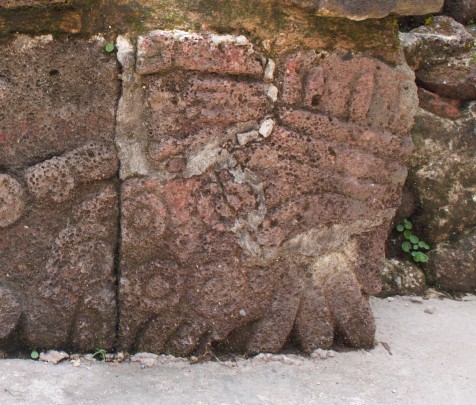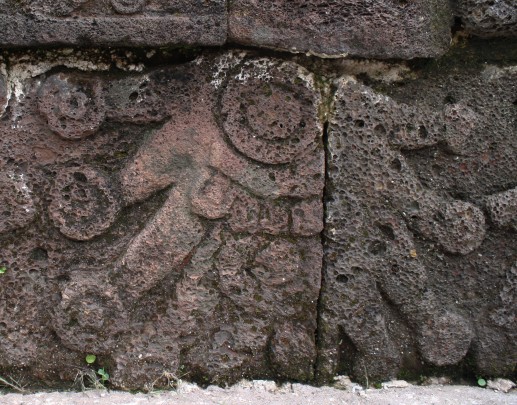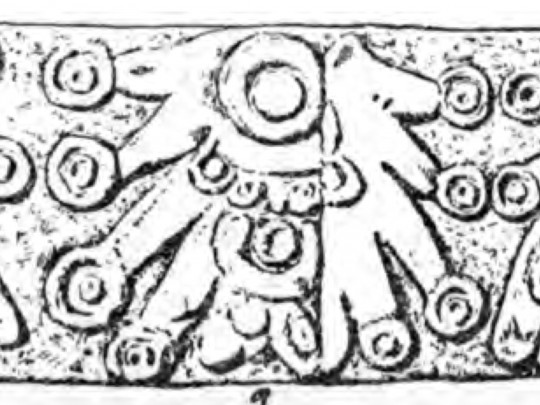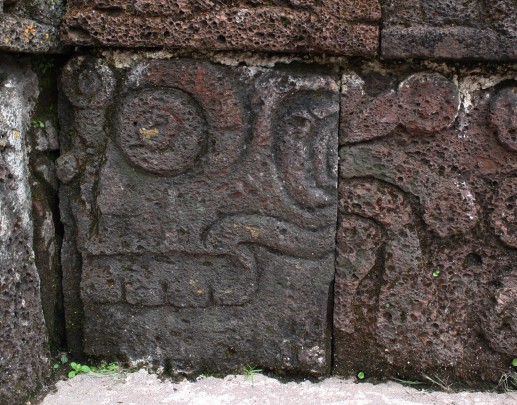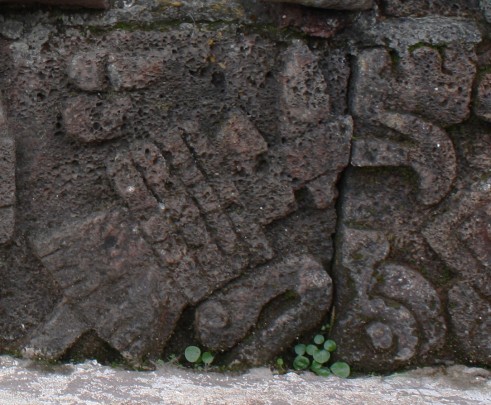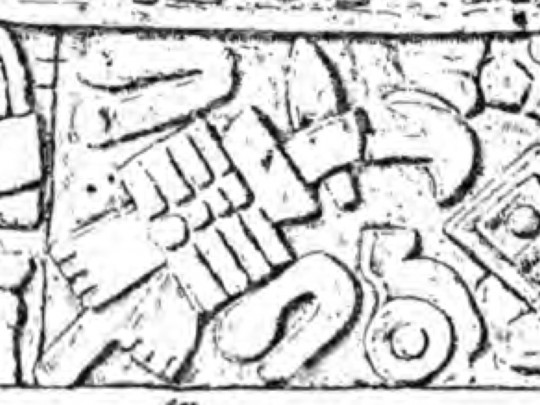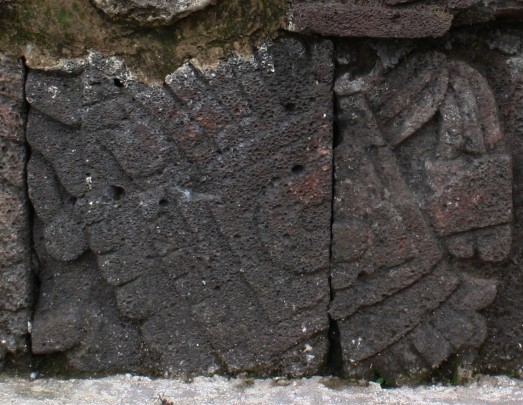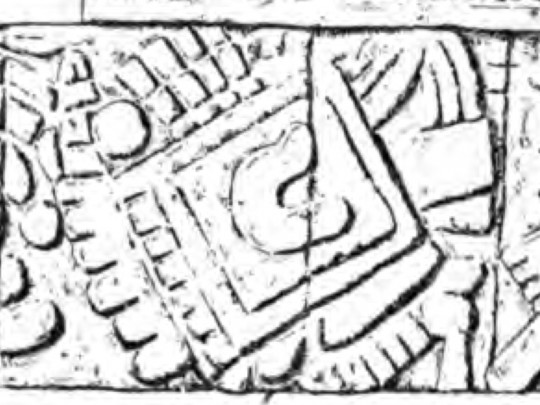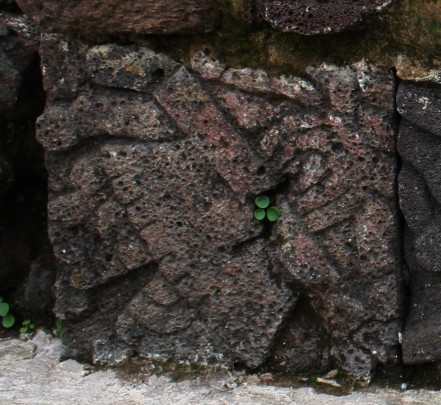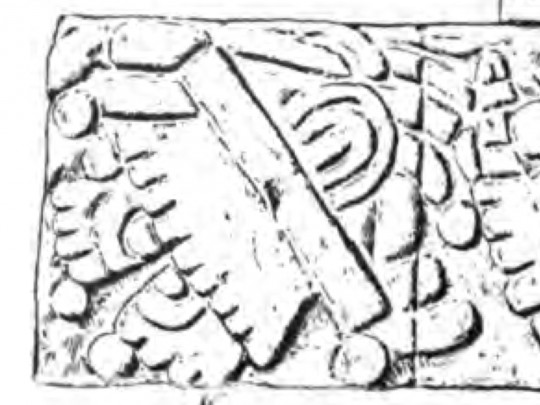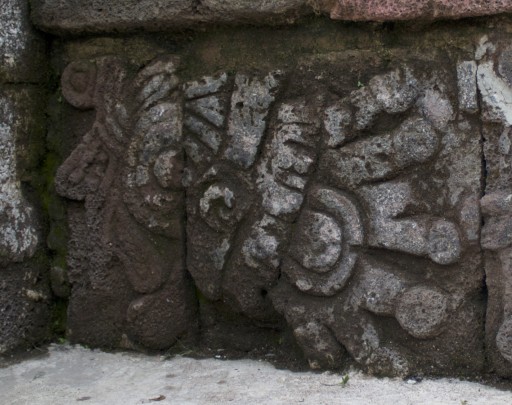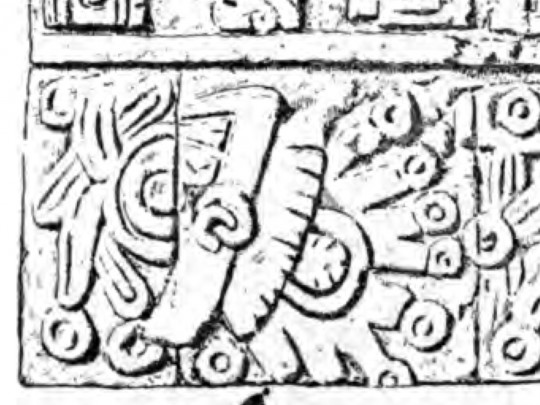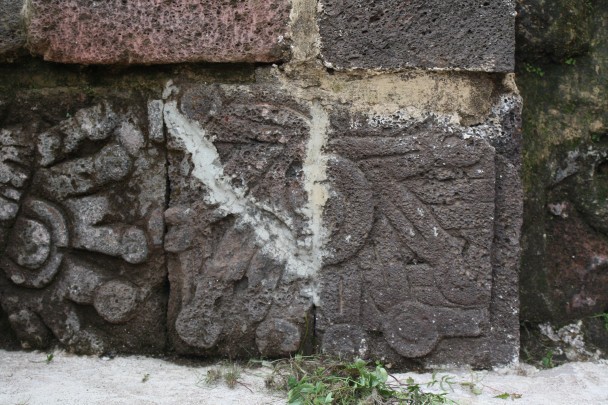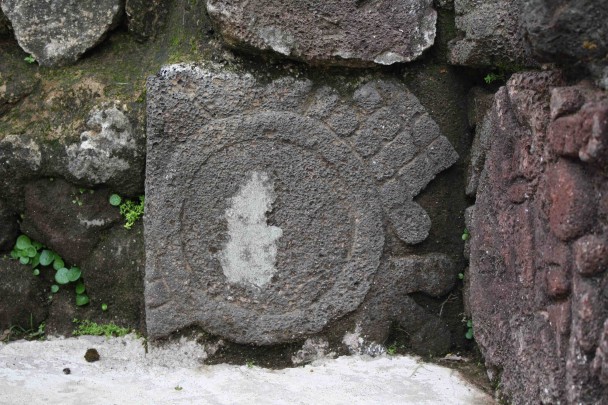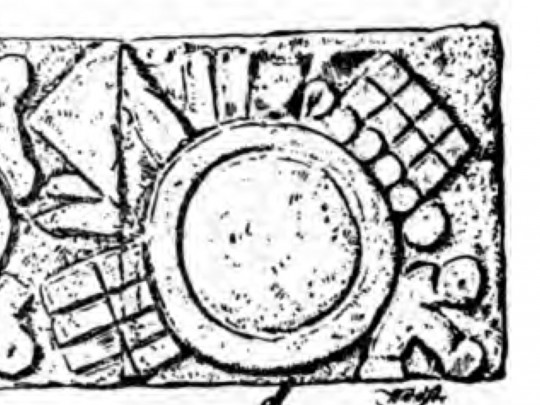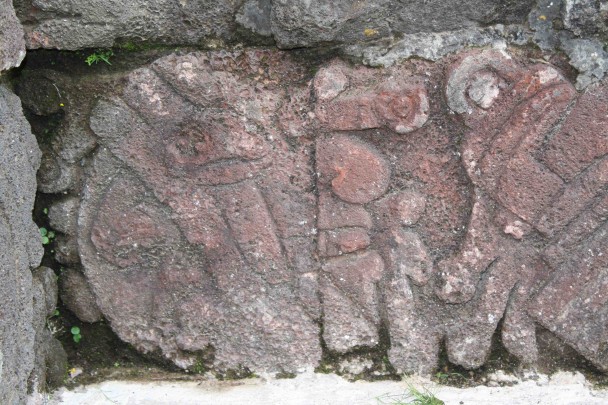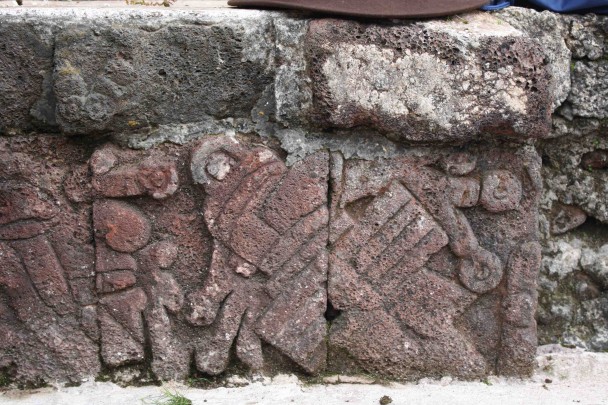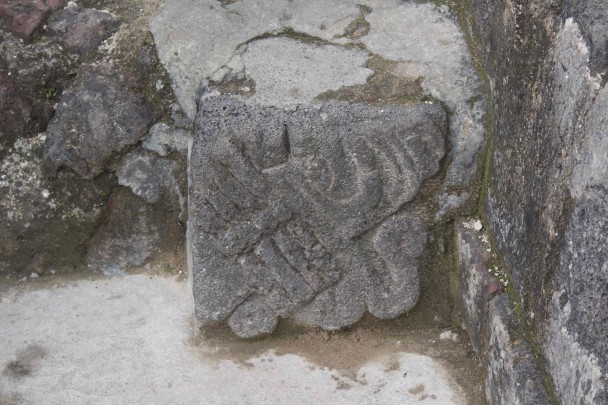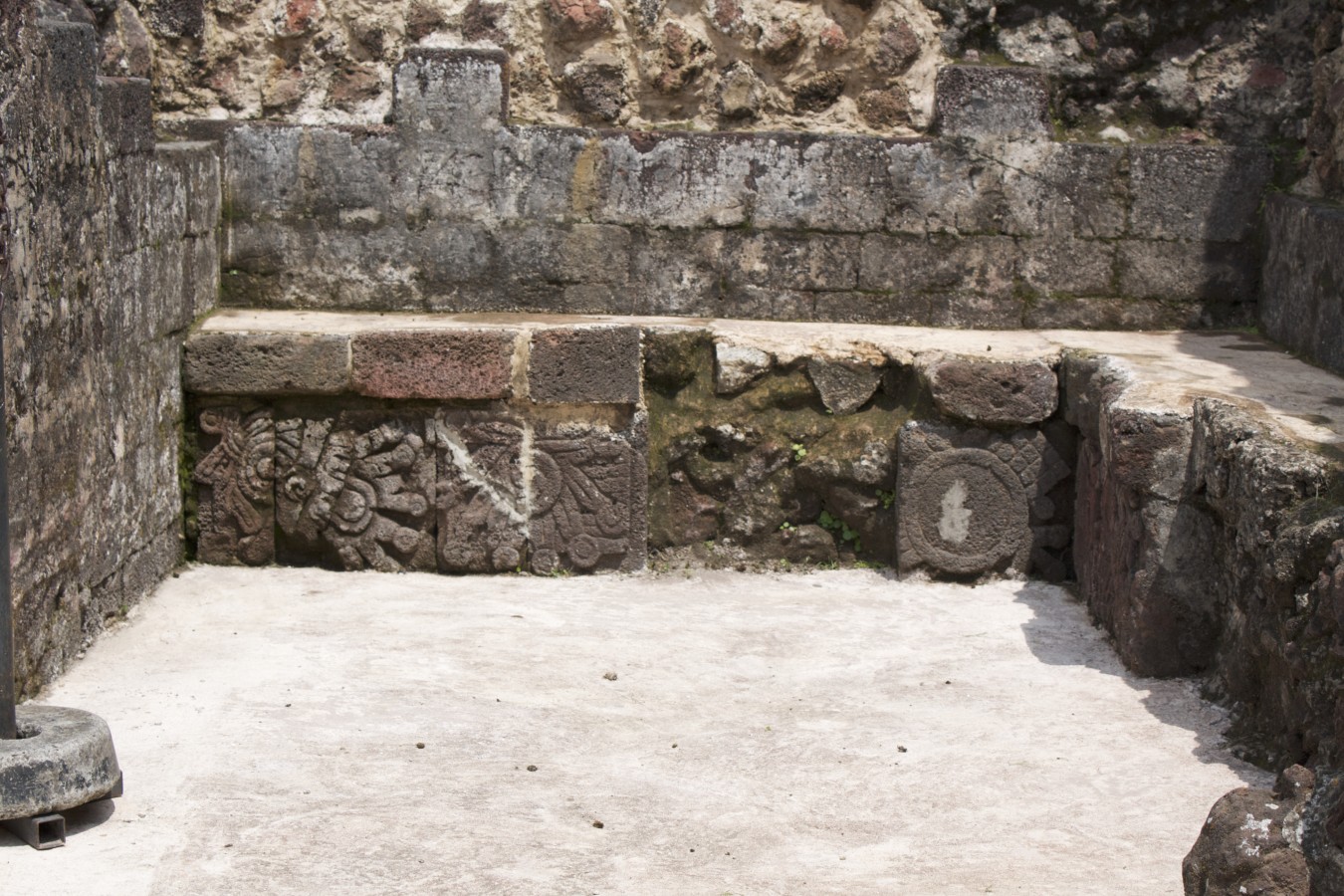Rectangular in shape, the bench in the temple of Tepoztecatl (the shrine’s main structure) runs along its north, east and south interior walls. It is decorated with reliefs and possibly functioned as an altar or seat where the effigy or sacred bundle of Tepoztecatl was placed.
Like the pillars, the bench is a clear example of the nonverbal communication system used in the Postclassic, as an entire discourse is constructed through the different signs. Some refer to the god Tepoztecatl, others speak of sacrifice and yet more allude to the responsibilities and power of the rulers. Here, we can see streams of water and blood, the “atl chinolli,” i.e. the burnt water which symbolizes the union of cold, earthly, feminine forces with hot, celestial, masculine forces that gave life to the universe.
Chief among the signs directly related to the power of Tepoztecatl are axes, pot of pulque, the shield and headdress. As regards sacrifice, of note are a skull from the tzompantli (skull rack), sacrificial rope, paper ornaments, bag of copal, round shield, blank flags and a decapitated head. Finally, the elements associated with the power of the rulers are the jaguar with feathers, claw of Tepeyollotl (“heart of the mountain,” the jaguar god), royal diadems (with signs for turquoise and flags), penitence and maguey thorns.
Sign 2. This is the first element of the bench that can currently be seen, although it is missing its right edge, which showed half of the sign of the jaguar. It depicts an extremity (a paw or a foot) decorated with five spots like those of a jaguar or ocelot. The paw or foot is injured at the level of the ankle, from which blood spurts. The stump is decorated with a line of four feathers. To the left are three streams of water that “push” or “pull” the sign. This is also a god, who is a man and a jaguar at the same time. This symbolizes the telluric forces that are part of the hill of Tepoztecatl.
Sign 3. This consists of two concentric circles, like shell or jade beads. From these hang a garland composed of a curved bar, like an inverted eyebrow. Below this motif are five shell beads. Further down hangs a larger bead than the previous five which is slightly smaller than the central one. It looks like two feathers are hanging at the bottom (it is impossible to be sure, because they are very deteriorated). Behind this sign are eight streams of a liquid with shell beads at the ends. Based on its shape and the fact that it lacks the central line for the depiction of water, this is a stream of blood pulling all the elements visible on this face of the bench towards the center. The central element (chalchihuitl) refers to a jade bead and is therefore something precious, so the sign could be interpreted as “precious blood.”
Sign 4. This consists of the left side of a skull, with an eye and an eyebrow at the top. We can see a perforation from which spurt three streams of blood, also decorated with shell beads. This perforation corresponds to the one made for placing skulls on the tzompantli. One of the streams has an additional motif of four small feathers that hang from the bead.
Sign 7. A stone ax whose handle is decorated with four paper bows, forming a single arrangement. We can see a stone wedged through the top of the handle, which is the axe blade. This tool was carried by the gods of pulque and is part of Tepoztecatl’s attire. Above and below, we can see two scrolls around it, and blood pulling it towards the center of the bench.
Sign 8. A rectangular shield on which we can see a U-shaped element that simultaneously represents a pot, a bone and, most importantly, the body of the moon. The ancient inhabitants believed that the moon was a pot full of water and a hipbone, and that a rabbit lived there. Both the moon and the rabbit are closely associated with pulque. This is why the gods of pulque wear a moon-shaped nose-ring and bear a moon on their shields. There are two rows of feathers decorating the shield at the bottom of the outer rectangle. There are four darts or arrows behind this, which indicated the god’s warrior status. We can see a pennant edged with long feathers at the top of the shield, as in the picture in the codex.
Sign 9. A paper ornament like a tassel with a loop at the top. Once again, this is a decoration carried by people who were to be sacrificed.
Sign 10. A bag of copal with a knot in the drawstring. This object was used for priestly activities. There is a water current edged with shell beads on the right-hand side of the sign. We can also see that blood is gushing from the bag, which indicates the atl-tlachinolli, a union of opposites that generate life and movement.
Sign 11. A pair to sign 3. In this case, this is a shell or jade bead from which nine streams of water gush. It is simpler than the other one, as it lacks the garland from which the bead hangs. The blood and water pull all the elements on the bench towards the center.
Sign 13. Only half of this sign is preserved. It consists of a round shield or chimalli which is blank (bearing no device). There are two different elements behind it: a small flag (pantli) which is also blank and a group of four darts pointing downwards with their feathers at the top. The round shield belongs to the set of elements that speak of sacrifice.
Sign 14. This depicts a head that has probably been decapitated, with half-open eyes, a very prominent nose, a half-open mouth and possibly a labret. Two lines are included, which may indicate face paint or even that the head is made of stone or some other rough material. Two streams of blood gush from behind the head.
Sign 15. A flint ax with a cosmic eye at the end of the handle. The latter is decorated with a quadruple bow from which two tassels hang. This is the ax carried by the god Tepoztecatl, behind which we can see at least four streams of blood.
Sign 19. An ax with a very wide head and a cosmic eye at the end. As with the previous cases, it has a paper adornment with four bows and a garland at the end. There are three streams of blood and smoke behind this sign.

